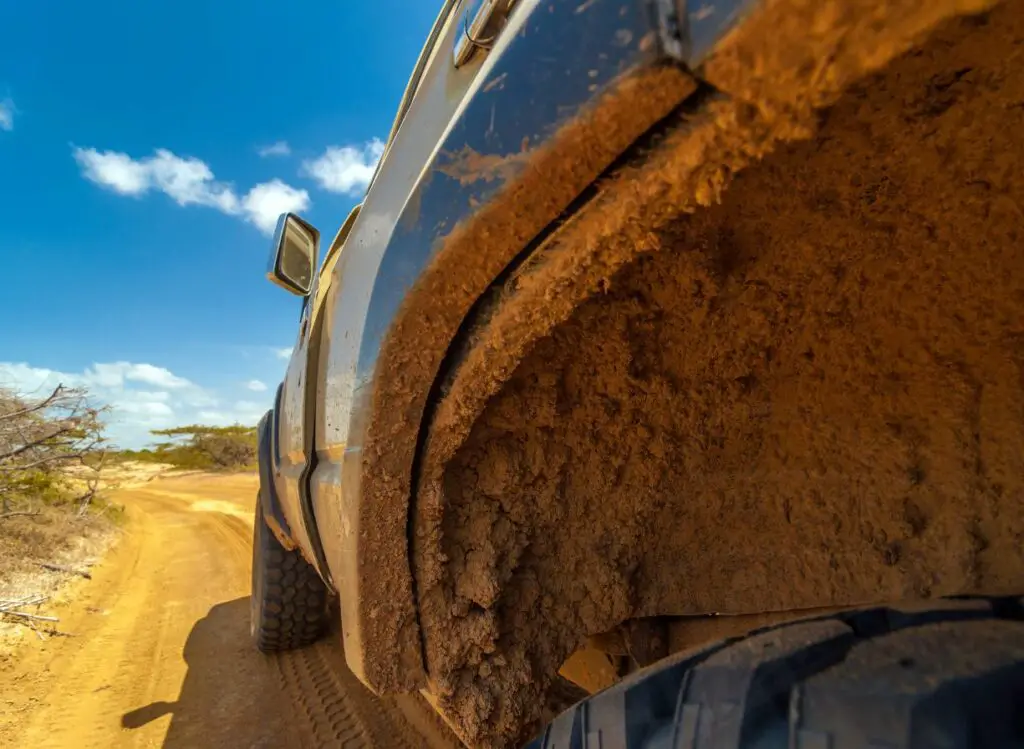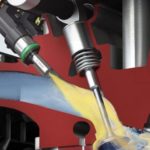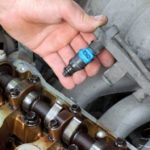
Wheel wells are usually neglected when it comes to car washing or detailing. But if not properly cared for, they can be a breeding ground for dirt, grime, and of course bugs! So, how to clean wheel wells and protect them?
I’m here to help you keep your wheel wells clean and protected. Follow these easy steps to learn how to wash them effectively without harming the paint on the outside of your car.
Table of Contents
What Is Car Wheel Well?
The wheel well is the space that can be found below the front and rear axles on both front and rear-wheel drive vehicles. It is basically a space where the tire and wheel are housed in a car. A wheel well is normally rectangular, but it may vary in size depending on the design of a certain model.
Check out: How to clean car tires like a professional!
Types Of Wheel Well Lining
The wheel well lining may differ between different cars. A wheel well liner is used to help protect the wheel well on the car from dirt, grime, and moisture. These liners are usually made out of one or more of the following materials.
Plastic
It can be made from other plastics such as vinyl or neoprene, but the wheels are usually kept in plastic whenever it is easy to wash and maintain.
Rubber
Rubber is a good choice because it helps lock the moisture inside the wheel well, preventing rusting and deterioration.
Aluminum
This is another material that can be used as a lining in order to prevent rusting.
Fiberglass
A wheel well liner made of fiberglass is often molded into 3D shapes so that it can fit snugly around the wheel well without causing friction or abrasion.
My Car Doesn’t Have Wheel Well Liners?
If you find your car doesn’t have wheel well liners, it isn’t a manufacturer’s mistake. As wheel well liners are not standard, some producers do not include them in their models, even for SUVs and trucks.
If you hate hearing rock chips noise, you can buy wheel well liners and install them yourself.
How To Clean Wheel Wells
Necessary tools and supplies
- Wheel brush or long-handled brush
- Soft-bristle brush
- Microfiber towels
- Wheel cleaner or degreaser
You can use different soap to clean wheel wells depending on what smell you want such as All-Purpose Cleaner, Simple Green, or Car Wash Concentrate. The Chemical Guys series wheel cleaners will be perfect if you’re detail-oriented.
Below steps can be applied to all wheel wells types.
Step-by-step instructions
Step 1: Prepare the wheel wells
Park your vehicle on a flat surface and ensure the engine is off. Then, remove any loose debris or mud from the wheel wells using a brush or your hands.
Step 2: Spray the wheel wells with water
Use a hose or a bucket of water to rinse the wheel wells thoroughly. Make sure that you spray water into all the nooks and crannies to remove loose dirt and grime.
Step 3: Apply a wheel cleaner or degreaser
Spray a wheel cleaner or degreaser onto the wheel wells, focusing on areas with visible dirt or grease. After that, allow the cleaner to sit for a few minutes to penetrate and loosen stubborn dirt.
Step 4: Scrub the wheel wells
Take a wheel brush or a long-handled brush and scrub the wheel wells gently in a circular motion. Pay close attention to areas with heavy dirt or grime buildup.
You should use a soft-bristle brush for more delicate parts.
Step 5: Rinse off the cleaner
Use a hose or clean water to thoroughly rinse off the wheel cleaner from the wheel wells. Ensure all the cleaner is removed, as leftover residue can cause streaks or stains.
Step 6: Dry the wheel wells
Use a microfiber towel or a clean cloth to dry the wheel wells completely.
Note: Pay extra attention to corners and crevices to avoid water spots.
Step 7: Apply a protective coating (optional)
If desired, you can apply a wheel well protectant or sealant to provide a layer of protection against dirt and grime in the future.
Step 8: Finishing touches

Clean the wheel rims using an appropriate wheel cleaner and a separate brush or sponge. Then, you can polish the tires with a tire shine product to enhance their appearance.
Troubleshooting Common Issues Related to Cleaning Wheel Wells
When it comes to cleaning wheel wells, you may encounter some common issues along the way. Here are troubleshooting tips for addressing these issues:
Lingering odors
Cause: Sometimes, wheel wells can develop unpleasant odors due to accumulated dirt, debris, or moisture.
Solution: Thoroughly clean the wheel wells using a wheel cleaner or degreaser to remove any trapped dirt or grime. Rinse with water and allow the area to dry completely. If the odor persists, you can use an odor neutralizer or deodorizer specifically designed for automotive use.
Stubborn stains
Cause: Certain substances like brake dust or road tar can leave stubborn stains on wheel wells.
Solution: Use a specialized wheel cleaner or a stain remover designed for automotive use. Apply the product to the stained area and let it sit for a few minutes to break down the stain. Then, scrub the area with a brush or sponge to remove the stain. Rinse thoroughly and repeat the process if necessary.
Dealing with painted wheel wells
Cause: Some vehicles have painted wheel wells, which require special care to avoid damaging the paint.
Solution: Use a mild car wash soap and a soft-bristle brush to clean painted wheel wells. Avoid harsh chemicals or abrasive tools that scratch or strip the paint. After cleaning, dry the area gently with a microfiber towel to prevent water spots. Applying a wax or sealant designed for painted surfaces can provide an extra layer of protection.
How To Protect Wheel Wells
If you have waxes or carnauba waxes, they are great protectants for your wheels. Apply them on your wheels using an applicator pad and a microfiber towel. Let it dry and repeat the application until you get the desired result.
How to Maintain Clean Wheel Wells

Maintaining clean wheel wells is crucial for your vehicle’s overall aesthetics and longevity. Here are some tips for regular maintenance and the recommended cleaning frequency:
- Regular visual inspection: Make it a habit to inspect your wheel wells periodically visually. Look for signs of dirt, debris, or corrosion. Catching any issues early can prevent further damage.
- Clean after off-road or muddy adventures: If you frequently take your vehicle off-road or drive through muddy conditions, it’s essential to clean your wheel wells promptly afterward. Mud and debris can accumulate quickly, leading to potential damage and corrosion.
- Clean seasonally: Plan to clean your wheel wells at least once every season. This will help prevent the buildup of road grime, salt, and other contaminants that can cause rust or corrosion.
- Use a pressure washer: A pressure washer can be helpful when cleaning your wheel wells. It can help remove stubborn dirt and grime effectively. However, use caution and avoid using excessive pressure that could damage delicate components.
- Apply a protective coating: After cleaning the wheel wells, consider applying a protective coating or sealant. This will create a barrier against dirt and moisture, making future cleanings easier and extending the lifespan of your wheel wells.
- Maintain tire pressure: Properly inflated tires can contribute to cleaner wheel wells. When underinflated tires tend to flex more, allowing dirt and debris to be thrown into the wheel wells, regularly check and maintain the recommended tire pressure.
- Clean your entire vehicle regularly: Keeping your entire vehicle clean, including the exterior, can indirectly contribute to cleaner wheel wells. Regular car washes and detailing sessions will minimize dirt and grime accumulating in the wheel wells.
- Address rust and corrosion promptly: If you notice any signs of rust or corrosion in your wheel wells, it’s crucial to address them promptly. Remove the rust using appropriate methods and apply a rust inhibitor to prevent further damage.
Remember, the recommended cleaning frequency may vary depending on your driving conditions and climate. More frequent cleanings may be necessary if you live in an area with harsh winters or frequently drive in salty or muddy environments.
Alternative Wheel Well Protection
In case you can’t find the wheel wells you want, there are several options you can choose to protect your wheel wells.
Rubber Undercoating
Undercoating is a very popular material used to protect wheel wells for many different reasons. These undercoating can range from one-component, two-component, or three-component formulations.
The main advantage of rubber undercoating is that it prevents moisture from reaching the car’s wooden parts, which is highly effective in protecting a car against rot. Also, it helps prevent rust from forming inside the wheel wells by locking off the moisture.
Rubber undercoating can come in a spray form to be quickly and directly applied on any wheel liner material. Yet, you need to reapply it quite often.
Spray-On Bed Liners
If you like the idea of using a spray-on, you can go for spray-on bed liners. These are plastic resins that are sprayed on the inside of a wheel well and allowed to dry. Then, this material is usually molded into place so it fits snugly.
Spray-on bed liners are effective because they prevent rust by acting like a shield that protects the wheel well and keeps moisture from corroding your car’s wooden parts.
However, there are some drawbacks of spray-on bed liners:
- Need to be applied often, as they wear off easily due to regular usage
- It’s hard to get an even finish
- Hard to remove
How To Install Wheel Well Liners
Preparation
The first step in installing wheel well liners is ensuring that your car already has nothing covering the wheel wells. In some cases, plastic parts might be installed over the wheel wells, preventing you from installing wheel liners. These pieces should be removed first.
If necessary, you may remove the part that covers your wheel wells for the time being. You can use a knife or even screwdrivers to remove these pieces from the wheel wells.
Proceed with Installing Liners
However, there are some parts that you can’t remove because they are integrated into the car’s design. In my car, I found out that the wheel wells were made out of plastic and didn’t have any metal pieces to protect them. So if this is the case with your car, you wouldn’t need to remove anything.
Measure your wheel wells and buy wheel well liners. You should use this opportunity to measure the width and length of your wheel wells to ensure that your wheel well liners fit correctly.
The first step in installing your liners is marking the appropriate location on the wheel well. You can use some masking tape and a marker to do this properly.
Just measure the distance from each side of your wheel wells until they meet at the middle.
Next, you are ready to install your liners in their respective locations.
You can use a contoured tip or a sharp object tool, like a knife or screwdriver, to mark the shape of your wheel liner on your wheel well.
Check out This Video for How to Clean and Protect Wheel Wells from Chemical Guys!
FAQs
#1 How do I keep my wheel wells black?
You can use a dressing, paint, or undercoating to keep wheel wells black. Each method has its own advantages. You can use your own favorite dressing to prevent wheel wells from fading or discoloring.
#2 Do wheel wells rust?
Yes, wheel wells do rust and they look horrible. Vehicle manufacturers consider the fact that you are likely to be driving your car every day, so it would be better to have a good-looking wheel well liner than a rusty one.
#3 How do I keep my wheel well from rusting?
The best way to prevent your wheel wells from rusting is to coat them with a protective sealant. This prevents additional moisture from forming and building up in the wheel well. You can coat your wheel well with spray-on protectants, like waxes and silicone, or paint or undercoating materials.
Waxes, like carnauba waxes, are some of the most popular materials used to prevent rust from forming in the first place for a long time.
#4 Can I clean my wheel wells with regular car wash soap?
Regular car wash soap is generally safe for cleaning wheel wells. However, for more effective results, it’s recommended to use a wheel cleaner or degreaser specifically formulated to tackle the dirt, grime, and brake dust that accumulate in wheel wells.
These specialized products are designed to provide better cleaning power and remove stubborn contaminants.
#5 How often should I clean my wheel wells?
The frequency of cleaning your wheel wells depends on various factors, such as your driving conditions and climate. As a general guideline, cleaning your wheel wells at least once every season is recommended.
However, if you frequently encounter muddy or salty road conditions or notice excessive dirt buildup, more frequent cleanings may be necessary to prevent corrosion and maintain the overall cleanliness of your vehicle.
#6 Is it necessary to remove the wheels to clean the wheel wells?
In most cases, removing the wheels to clean the wheel wells is unnecessary. With the right tools and techniques, you can effectively clean the wheel wells without taking off the wheels.
However, if you prefer a more thorough cleaning or if you need to address specific issues, such as rust or corrosion, removing the wheels can provide better access and allow for a more detailed cleaning process.
#7 Can I use a pressure washer to clean my wheel wells?
Yes, you can use a pressure washer to clean your wheel wells. However, it is important to use caution and avoid excessive pressure, damaging delicate components, or forcing water into areas where it shouldn’t go.
Use a medium-pressure setting and keep a safe distance from the wheel wells while spraying to effectively remove dirt and grime without causing any harm.
#8 Are there any specific products to avoid when cleaning wheel wells?
Avoid using harsh chemicals, strong acids, or abrasive cleaners when cleaning wheel wells, as they can damage the surrounding components or strip protective coatings.
Also, avoid using wire brushes or abrasive tools that can scratch or harm the wheel wells’ surfaces. Stick to products specifically formulated for automotive use and use soft-bristle brushes or sponges to ensure safe and effective cleaning.
Final Words
In short, car wheel wells do get dirty and have a tendency to rust. You must keep them clean for your wheels to look great and safe. As you can see in this guide, wheel well protection is not easy, but it’s definitely possible.
Check out: How to make your own wheel chocks!
With proper care, your wheel wells will look great and contribute to your vehicle’s overall well-being. So, roll up your sleeves, give your wheel wells the attention they deserve, and enjoy a cleaner, more pristine ride.
Hi everyone, My name is Ollie Barker.
As a seasoned auto expert I have 25 years of experience working in repair and detailing shops. I love to share my tips & tricks to all car lovers, so that’s why I’m here at Automotive Gearz publishing my content, sharing my passion. Also, I’ve been giving my recommendations on which products are the best to have on the market. I always thought it was hard to pick the right part, so hopefully I can make that a bit easier for you.
Hope you enjoy your time on my little blog!







